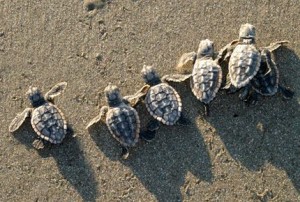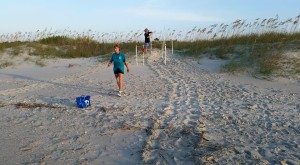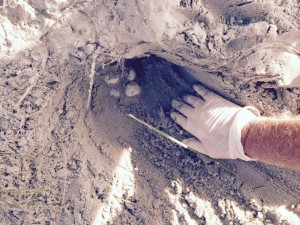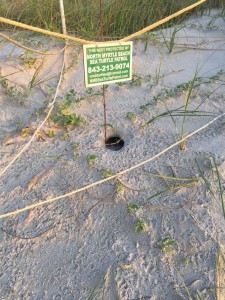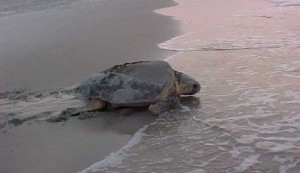WHAT CAN YOU DO TO HELP SEA TURTLES?
- Report any Sea Turtle Activity to the North Myrtle Beach Sea Turtle Patrol @ 843-213-9074, any time day or night. This includes nesting females on the beach, sea turtle tracks, stranded turtles, or hatchlings. But do not touch or disturb any turtle – it is against the law.
- Remove obstacles from the beach after dark, including tents, chairs, coolers, etc.
- Fill in all holes before you leave the beach.
- Pick up any and all liter.
- Pick up after your pets.
BRIARCLIFFE ACRES SEA TURTLE PATROL (more info for BAA Members here)
Briarcliffe Acres has a group of volunteers dedicated to Sea Turtle Conservation via participation in the North Myrtle Beach Sea Turtle Patrol (NMBSTP), which in turn works under South Carolina United Turtle Enthusiasts (SCUTE) and is permitted by the S.C. Department of Natural Resources. The NMBSTP leaders are authorized by the SC Department of Natural Resources to conduct research and management activities regarding sea turtle conservation.
For stranding activities, leaders are authorized to measure and mark dead sea turtles, and transport or transfer sea turtle specimens in SC. For nesting activities, the leaders are authorized to identify and mark nests, inventory nests after emergence, recover hatchlings, probe to locate egg clutches, relocate nests, cage nests, and collect one egg shell from each nest for genetic research study.
S.C.U.T.E was organized in 1990, and the NMBSTP in 2010. On the average, there are over 100 loggerhead nests with more than 12,000 eggs recorded each year along the Horry-Georgetown Beaches.
The Briarcliffe Acres Sea Turtle Patrol is responsible for the stretch of beach starting at the swash on the north end, all the way to the Lands End Condominium complex on the south end (including the Meher Center Beach). Volunteers walk this stretch of beach every morning at sunrise from May 1 thru mid August looking for tracks in the sand which would indicate a sea turtle laid a nest of eggs. The nest is located, moved if necessary, and then marked and key data recorded. The nest will be monitored daily for signs of any disturbances, and finally for signs of emergence 45-65 days later. The volunteers inventory nests four days after emergence to determine then number of eggs, and how many hatched. All are invited to attend these inventories.
In 2017, there were four turtle nests along the Briarcliffe Acres & Meher Spiritual Center beaches, and one relocated from Apache Pier, for a total of 636 eggs. There was a 78% hatchling survival rate. If statistics are correct, approximately 2 of the hatchlings will survive to sexual maturity in about 20 years.
DNA results showed Nests #1 & #2 were from the same mother, who laid a total of four nests this year: one in Myrtle Beach, two on Briarcliffe Acres Beach, then one in North Myrtle Beach. Previously this turtle nested in 2013 with six nests on Topsail Beach and Emerald Isle.
Likewise, Nests #3 & #4 were from the same mother that started with a nest in North Myrtle beach before the two on Briarcliffe Acres Beach, and finished with a forth nest in North Myrtle Beach. This turtle was first recorded in this area in 2012 with four nests on Briarcliffe Acres Beach, in 2015 with one nest in Myrtle Beach and four on Briarcliffe Beach.
FAQ’s (FROM NMBSTP BLOG)
Q: What kind of sea turtles nest in North Myrtle Beach?
A: Mostly loggerheads (Caretta caretta), a “northern sub-species” that nests in GA, SC, NC, and are genetically distinct from the “southern” (Florida) species; this population is much smaller than southern.
Q: When do they nest?
A: About May until about mid-August.
Q: How big are they?
A: About 3 feet long and almost as wide; 250-350 pounds.
Q: How do they make the nest?
A: They dig with their back flippers.
Q: How long does it take?
A: About 30-45 minutes just to dig; another 30-45 minutes to emerge from ocean, crawl up the beach and then return to the ocean.
Q: How deep are the eggs?
A: Bottom of the nest is typically about 18 inches, but topmost eggs can be only 8-10 inches from the surface.
Q: How many eggs per nest?
A: Average of 120 ping pong sized eggs.
Q: How many nests do female Loggerheads lay?
A: Loggerheads reach sexual maturity at age 17-33 years, and have a lifespan of 47-67 years. A female lays an average of four egg clutches in a single year, and then becomes quiescent, producing no eggs for two to three years.
Q: How long does it take the eggs to hatch?
A: About 45 – 65 days, depending on the sand temperature.
Q: Does the mother protect the nest?
A: No.Once she the eggs are laid, the mother returns to the ocean and never sees the nest, eggs or hatchlings again.
Q: Why is a nest moved?
A: When it is laid below the spring high tide line and in danger of being over washed.
Q: What can harm the eggs?
A: Too much heat, too much water, bacteria in nest, and nest diggers (roots, ants, sand crabs, dogs, people).
Q: What are the main predators of hatchlings?
A: Ants, ghost crabs, dogs, birds, fish, and people.
Q: What are the main predators of adult turtles?
A: Sharks, boats/ships, fishing nets and lines, trash, pollutants, diseases, obstructions on beach, and people.
Q: When is the best time to see a turtle nesting or a nest hatching?
A: Both events usually take place at night. To feel safe, the nesting turtles need a natural habitat (dark, quiet, motionless). To have the best chance to make it safely to the ocean, the hatchlings need natural lighting with no obstructions between the nest and the ocean.
Q: Where do hatchlings go when they enter the ocean?
A: Small turtles float in the Sargasso Sea along the major North Atlantic currents.
Q: How many hatchlings survive to sexual maturity?
A: Recent research suggest approximately 1 in 1,000.
Q: What do I do if I find a hatchling on the beach during the day?
A: The hatchling needs to get into the water as quickly as possible. It should be placed on the wet sand at the water line to rehydrate if necessary. If it is active, it can be walked out beyond the breakers and released into the water. It is against state and federal law to remove the hatchling from it’s natural environment.
Q: What if I see a sick or injured sea turtle on the beach?
A: If a turtle has stranded on the beach, it is sick or injured. Do not push back into the water. Call the NMB Sea Turtle Patrol at 843 213-9074 or the SCDNR Hotline at 800-922-5431. It is recommended that the turtle be shaded and wet towels placed on it’s carapace to avoid overheating.
Q: Can I take home a piece of shell or part of a turtle skeleton?
A: All sea turtles in the US are State and Federally protected. It is against the law to have any live turtles or their parts.
USEFUL LINKS
(These links open in a separate tab or window. To return here, close the new tab or window.)

